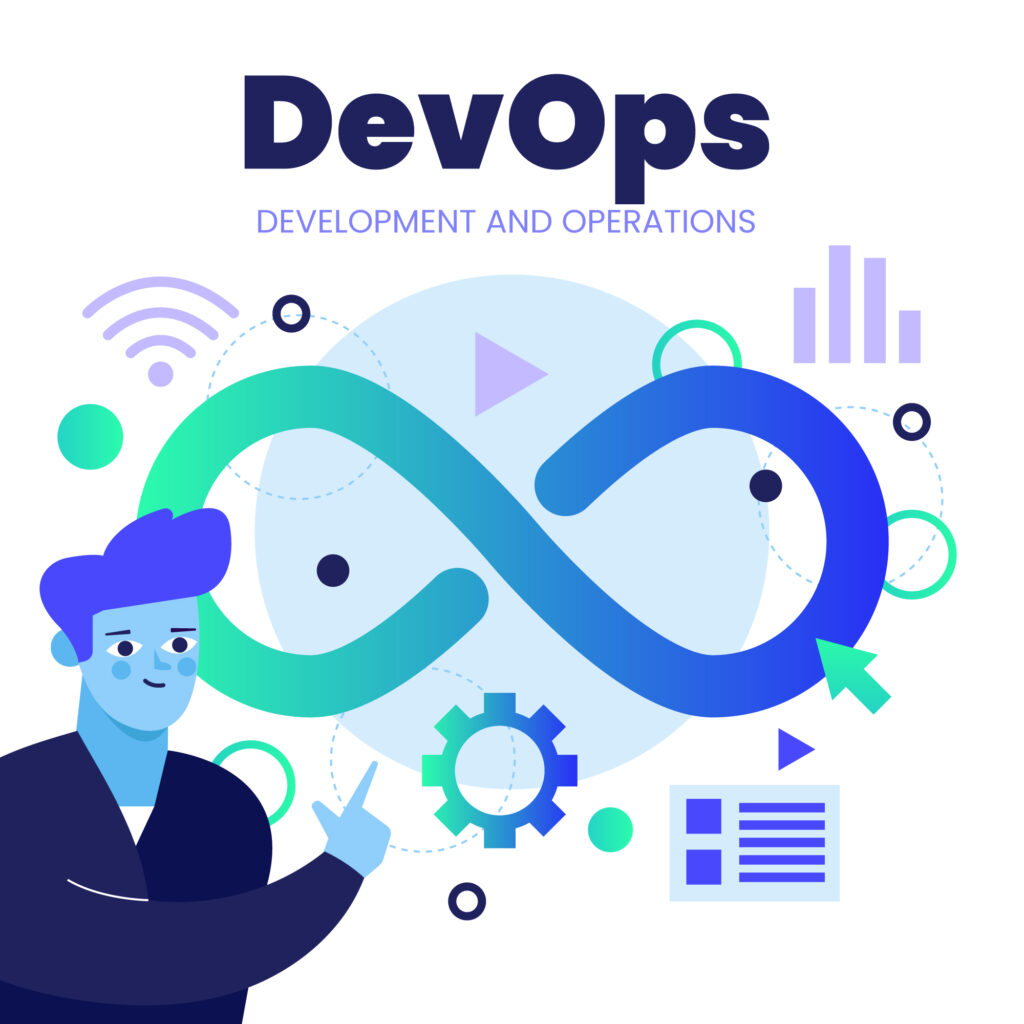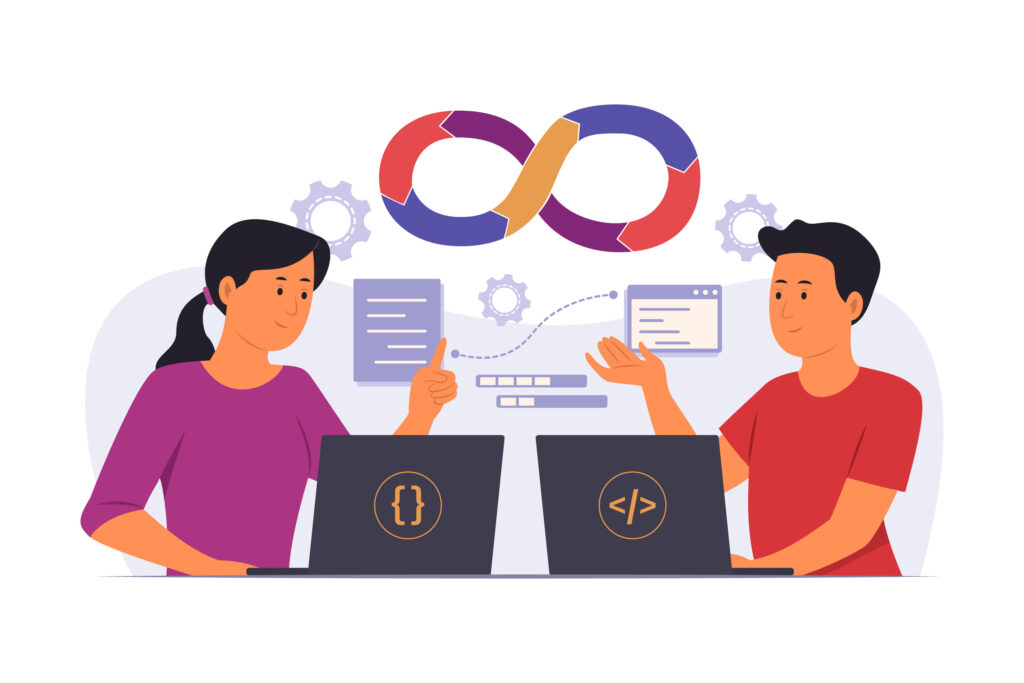It is important to learn more about the CALMR approach to DevOps. Software development and delivery have become integral to the success of businesses across industries. DevOps, a collaborative approach that combines software development (Dev) and IT operations (Ops), has emerged as a game-changing methodology to streamline processes, foster innovation, and accelerate time-to-market.
Central to the DevOps philosophy is the CALMR approach, an acronym that stands for culture, automation, lean, measurement, and recovery. This comprehensive framework serves as a roadmap for organizations looking to harness the full potential of DevOps practices. In this article, we will delve into the intricacies of the CALMR approach, exploring its components, benefits, and its transformative impact on DevOps adoption.
What does the CALMR Approach Mean in DevOps?
DevOps isn’t just a method, it’s also a way of thinking, culture, and technical practices. It helps people communicate better and work together more closely when planning, testing, developing, deploying, releasing, and maintaining software.

DevOps bridges the gap between development and operations teams so that everyone can work together better. This makes it easier to deliver software quickly and efficiently. Without DevOps, there is often friction between the people designing software and those who need to support and maintain it.
CALMR is one of the most popular DevOps methods. CALMR stands for culture, automation, lean, measurement, and recovery. It’s a set of best practices that helps people transition to DevOps more easily.
The CALMR framework for DevOps has five parts that work together to help people adopt DevOps practices successfully. First, it’s important to change the way people think so that everyone can work together better.
Then, automation can be used to make things more efficient and to reduce the need for manual work. Lean principles can help reduce waste and make things more efficient. Measuring progress is important so that people can see what’s working and what’s not. Finally, having a good recovery strategy helps people get back on track quickly if something goes wrong.
Why Adopt the CALMR Approach in DevOps?
The CALMR approach to DevOps is all about making things simpler, faster, and better. It involves teamwork, automation, smarter processes, measuring progress, and being ready for anything.
By using the CALMR methodology, organizations can improve their software development and delivery, making it more efficient and effective. To do this, they need to focus on five key areas:
- Culture: This means working together and sharing knowledge to get things done better and faster.
- Automation: This is about using technology to take care of repetitive tasks, so people can focus on more important things.
- Lean Principles: This involves streamlining processes to save time and reduce waste.
- Measurement: This means tracking progress and using data to make better decisions.
- Recovery: This is about having a plan in place to deal with problems when they happen, so things can get back to normal quickly.
By using the CALMR approach, businesses can:
- Create better products that are more innovative, secure, and high-quality.
- Get products to market more quickly with fewer risks.
- Improve the quality of their solutions.
- Solve problems faster and with fewer errors.
- Recover more quickly from production incidents.
If you want to learn more about DevOps and the CALMR approach, you can get certified online and become an expert in this exciting field. This will help you play a key role in your company’s success and growth.
The Components of the CALMR Approach in DevOps
DevOps is a modern software development practice that combines development and operations to make the software delivery process smoother.

Although automation is often the main focus of DevOps discussions, a more effective implementation requires a more comprehensive approach. That’s where the CALMR approach comes in handy.
CALMR provides a complete framework that helps DevOps professionals develop and implement strategies to promote continuous collaboration and value delivery across teams.
Let’s delve deeper into its core components:
1. Culture
DevOps leverages a culture that integrates the Lean-Agile framework’s principles, practices, and mindsets. It facilitates the upstream transfer of certain operational responsibilities through DevOps, while developmental tasks progress downstream to deployment.
Within a DevOps CALMR environment, teams actively use and monitor the solution.
Key values underpinning this culture include:
- Customer Centricity: The worth of an organization is gauged by its ability to identify and cater to customer requirements. Everyone participating in the value stream (VS) must be acutely aware of the customers they serve.
- Cooperation: Seamless collaboration among production, management, security, and other stakeholders is pivotal in DevOps. Regular interactions among these teams ensure that solutions are crafted, sustained, and evolved in alignment with evolving business needs.
- Risk Tolerance: DevOps fosters a collective understanding that every delivery is essentially an experiment until validated by customers. DevOps cultures encourage taking calculated risks and emphasize continuous learning and growth.
- Knowledge Sharing: Facilitating the exchange of information across departments, Agile Release Trains (ARTs), and the entire enterprise fortifies the organization. It also facilitates a shift towards proactive problem-solving and innovation.
2. Automation
Given that manual operations can be time-consuming and prone to errors, DevOps prioritizes rapid value delivery, enhanced productivity, and robust security. Manual processes also introduce the risk of errors that could potentially stall project completion.

The CALMR approach in DevOps advocates for automation, manifested through a Continuous Delivery Pipeline (CDP) integrated as a ‘tool chain’. This integration aims to reduce overall processing times and shorten feedback loops. Furthermore, customer and stakeholder feedback serves as valuable evidence to identify areas needing improvement.
Within the framework of the DevOps CALMR approach, a Continuous Delivery Pipeline (CDP) comprises the following components:
- Value Stream Management: Solutions for Value Stream Management offer real-time insights into the efficiency and quality of the value stream throughout the continuous delivery pipeline.
- Version Management: These tools monitor and oversee necessary modifications to configuration and source files that dictate the behavior of applications, infrastructure, and systems.
- Infrastructure as Code (IaC): All systems are viewed as customizable, ephemeral assets in the Infrastructure-as-Code paradigm.
- Automated Testing: Test automation is pivotal for accelerating delivery. This encompasses various testing types such as unit, component, integration, performance, regression, acceptance, and usability testing.
- Vulnerability Identification: These specialized tools scan significant segments of the continuous delivery pipeline to pinpoint security vulnerabilities in infrastructure, networks, and code.
- Continuous Integration: Upon a developer’s code commit, these tools are typically triggered automatically to oversee the build, development, testing, compliance, and deployment phases.
- Analytics and Monitoring: These technologies collate usage and performance data from all layers of a solution stack, providing crucial insights into pipeline efficiency, quality, and delivered value.
3. Lean Flow
Effective Agile methodologies and practices aspire to achieve a state of continuous flow. This can be conceptualized as a push for software delivery in smaller, more manageable batches. Such an approach curtails Work-in-Progress (WIP) and provides real-time visibility into software development.
This streamlined approach culminates in increased release frequencies, cost-effectiveness, enhanced predictability, expedited feedback loops, and minimized rework. Lean flow is instrumental in hastening delivery timelines while ensuring consistent service delivery.
Key components that bolster the CALMR approach in DevOps encompass:
- Minimize Work-in-Progress (WIP): Utilizing a program kanban makes WIP transparent to all stakeholders. This transparency allows all teams to identify and understand existing bottlenecks. Consequently, the WIP can be adjusted in alignment with available capacity and development resources.
- Reduced Batch Sizes: Employing smaller batch sizes facilitates faster movement through the system, expediting the learning curve in the process.
- Manage Queue Lengths: The length of a queue serves as a reliable indicator of task completion time. Effective management of wait times is crucial to maintain swift flow. Extended queue lengths invariably lead to longer delivery times.
4. Measurement
Continuous evaluation of the delivery pipeline and its resultant outcomes is essential in DevOps. Organizations need to establish robust telemetry systems to pinpoint flow impediments and ascertain if the quality delivered aligns with customer expectations.
Various Key Performance Indicators (KPIs) gauge progress, including lead time, cycle time, quality metrics, deployment frequency, and WIP volume, among others.
Key metrics that warrant consideration encompass:
- Lead Time: This refers to the duration from the initiation of development to the delivery of a functional product.
- Deployment Frequency: This metric elucidates how frequently a new product version or modification is rolled out to production.
- Return on Investment (ROI): It quantifies the benefits realized from investing in DevOps initiatives.
- Net Present Value (NPV): NPV serves as an indicator of a project’s value, calculated based on the anticipated future cash flows discounted to present value terms.
- Customer Ticket Volume: This denotes the number of support tickets raised by customers on a monthly basis.
- Customer Satisfaction: This metric captures the proportion of customers content with the provided solutions.
- Time to Restore: It signifies the average duration between problem identification and service restoration after implementing a solution.
5. Recovery
Without established recovery processes and without simulating failures, rapid delivery becomes perilous. Organizations need to strategize on swiftly rectifying issues by either reverting to previous states or advancing them forward.
Architect the continuous delivery pipeline to facilitate low-risk releases and prompt recovery post operational glitches to enable consistent and frequent value delivery.
The following techniques are employed within the CALMR DevOps approach to expedite delivery:
- “Stop-the-Line” Approach: When an issue jeopardizes the value of a solution, team members employing a “stop-the-line” strategy halt ongoing operations to address the issue promptly. Subsequently, the lessons learned from resolving the problem inform permanent fixes.
- Plan and Rehearse for Incorrect Deployments: Mistaken deployments aren’t uncommon in DevOps; they sometimes become anticipated. Teams should formulate recovery strategies to mitigate the impact of such failures and bolster solution resilience. Furthermore, these plans should be regularly rehearsed in genuine or near-real production environments.
- Rollback and Remediate: Given that production failures can be inevitable, DevOps teams need to adeptly “remediate forward” and potentially revert to a previously stable state if necessary.
In Agile methodologies, high-quality programs stem from the consistent merging of diverse sources. SAFe integrates the principles, practices, and culture of DevOps. While the DevOps transformation demands additional preparation and dedication, the rewards are significant.
People often emphasize that persistence paves the way to triumph, and the CALMR approach to DevOps guides this journey.
[Want to learn more about DevOPs Click here to reach us.]
Conclusion
The CALMR approach in DevOps offers organizations a holistic and structured framework to foster collaboration, drive automation, optimize processes, measure performance, and enhance resilience. By embracing this methodology, businesses can navigate the complexities of modern software development with confidence, delivering innovative solutions faster, and with reduced risks.
As the digital landscape continues to evolve, the CALMR approach serves as a guiding principle, empowering organizations to thrive in an ever-changing environment. In conclusion, adopting the CALMR methodology is not just about implementing a set of practices but cultivating a culture of continuous improvement, collaboration, and excellence, which is crucial for businesses today. With the support of an outsourcing team such as Bobacres, you can easily manage all of the aspects of DevOps.
PREVENT YOUR SERVER FROM CRASHING!
Never again lose customers to poor server speed! Let us help you.
Our server experts will monitor & maintain your server 24/7 so that it remains lightning fast and secure.




0 Comments